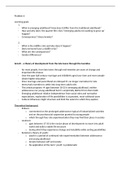Summary
Summary Algebra
- Course
- Institution
Quadratic Equation – Theory 1 – 10 Complex Number – Theory 11 – 25 Sets, Relations and Functions – Theory 26 – 46 Quadratic Equation – Exercise – 1 A1 – A5 Complex Number – Exercise – 1 A6 – A10 Sets, Relations and Functions – Exercise – 1 A1...
[Show more]





